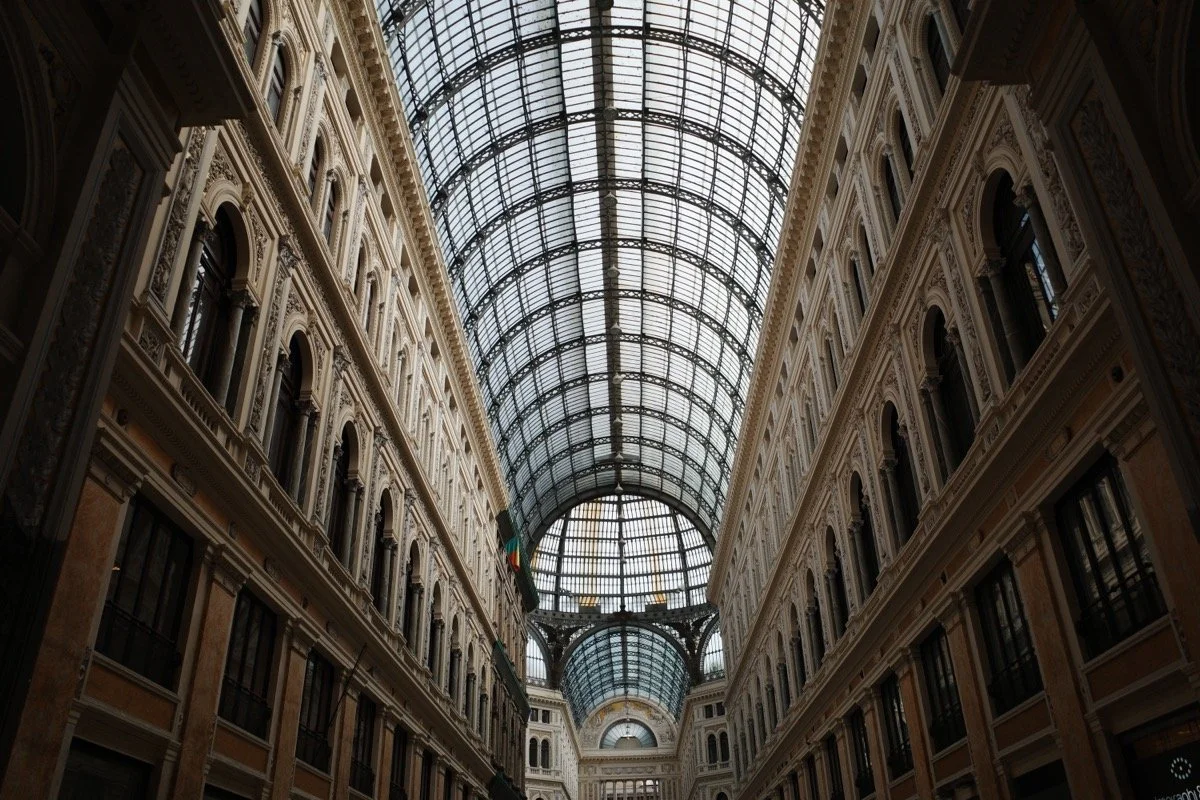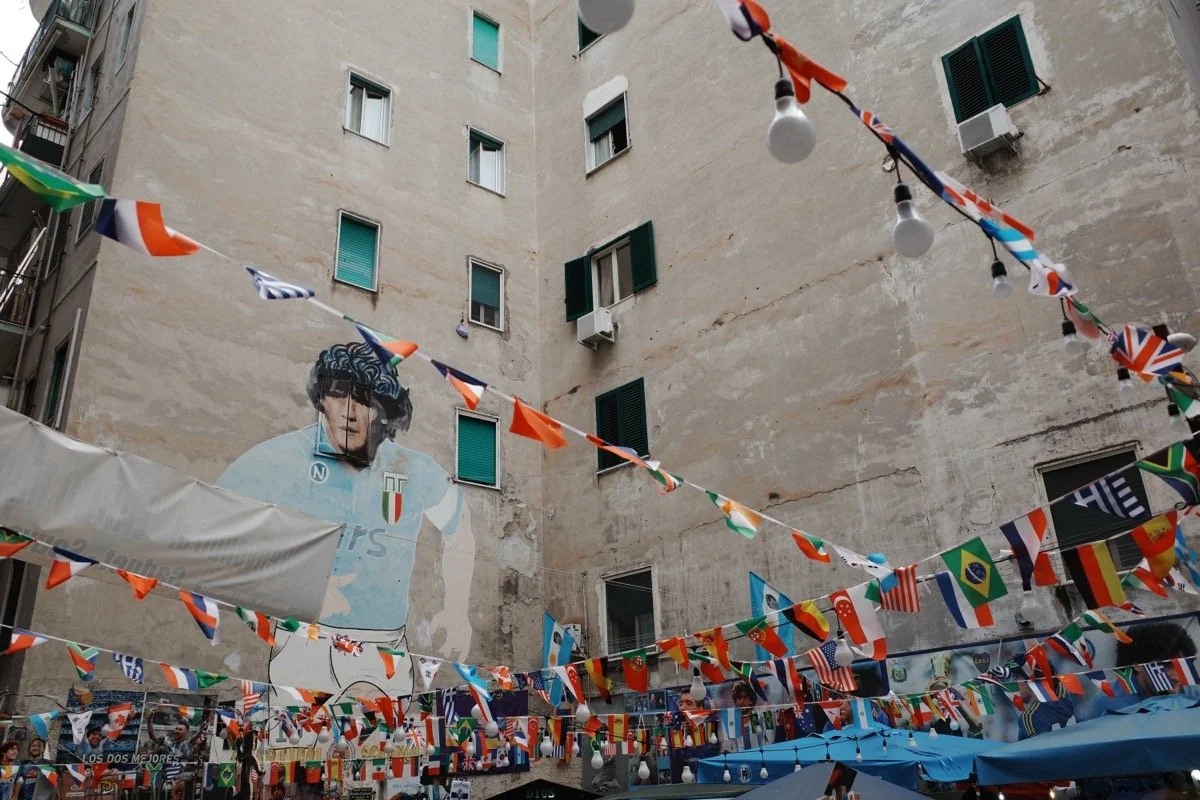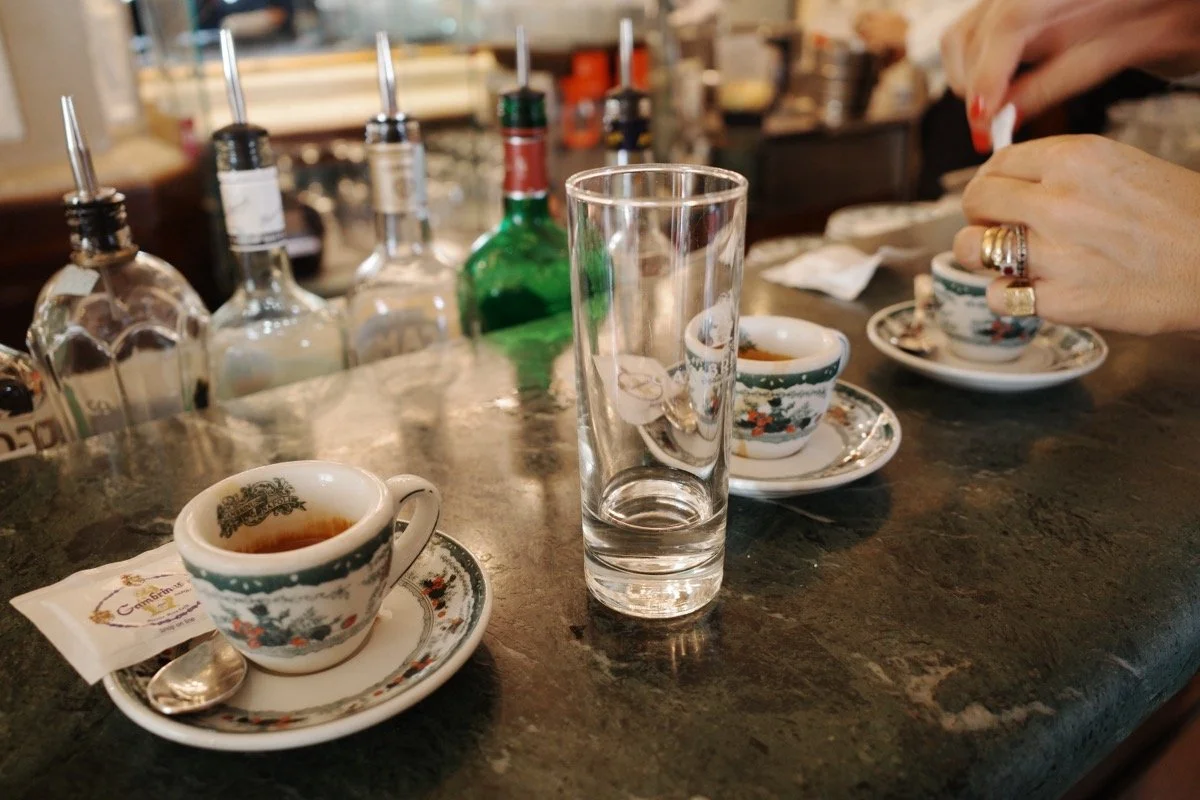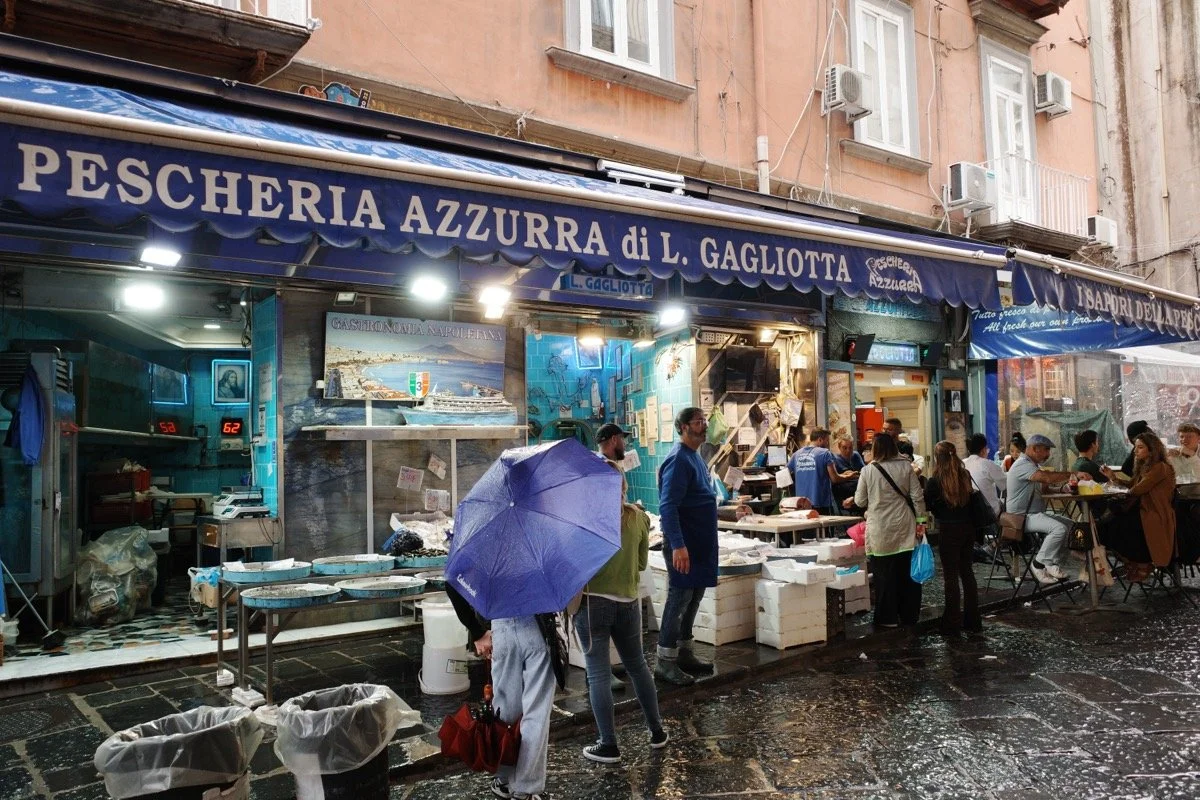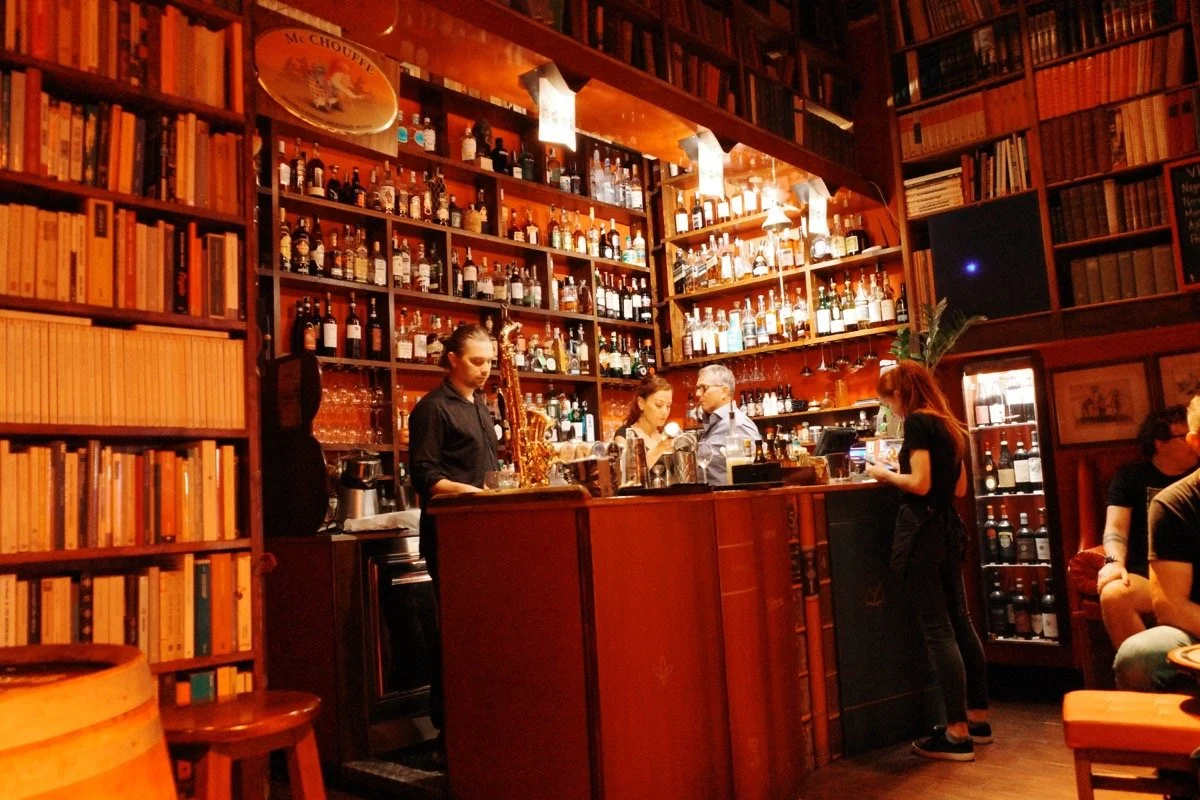Things to Do in Naples: Food, Culture & Surprises from a Misunderstood City
When we told friends that we’d included Naples in our Italy itinerary, the reactions were mixed — “It’s chaotic,” “Be careful, it’s not safe.” Honestly, we almost skipped it. But I’m so glad we didn’t.
Naples ended up being one of our favourite cities in Italy. Yes, it’s gritty. But it’s also raw, real, and wildly full of life. And the turning point for us? A walking tour with Maria, a local guide who completely reframed how we experienced the city. Her stories gave context to the chaos, made us feel welcome, and showed us a side of Naples we would have easily missed on our own.
Here’s a round-up of our favourite experiences, eats, and cultural surprises — starting with the walking tour that changed everything.
How to Use This Guide
Here’s what’s inside:
Walking Tour with a Local – Our #1 recommendation to get your bearings and fall in love with the city’s vibrant energy.
Where to Eat – Local gems and must-try dishes, including one of the best pizzas we had on our trip.
Where to Drink – A part bookstore, part wine and cocktail bar, tucked away on the literary stretch of Via Port’Alba
Where to Stay – The hotel we stayed at and what we liked about the area.
Day Trips from Naples – Especially helpful if you're considering visiting Pompeii (with our take on what not to do).
Travel Tips – Helpful tips on getting to/from Naples and answers to common questions like “Is Naples safe?”
Use this guide to plan your time in Naples or to reassure yourself that it’s worth including in your Italy itinerary — because it truly is.
Start with a Walking Tour: A Local's Naples (Highly Recommended)
If there’s one thing you do in Naples, let it be this.
Our walking tour with Maria was hands down the best way to kick off our time in the city. She helped us make sense of Naples — not just its geography, but its soul. From its grand piazzas to its chaotic backstreets, Maria gave us the confidence to explore on our own, and the stories to fall in love with what we saw.
The tour took us through:
Piazza Municipio, Piazza Trieste e Trento, and Piazza del Plebiscito – grand public squares where you’ll spot everything from palaces to political buildings.
Maschio Angioino (New Castle) and the Royal Palace – perfect for understanding Naples’ layered history of rulers.
Galleria Umberto I – this gorgeous glass-roofed arcade looks a lot like Milan’s Galleria Vittorio Emanuele II, but with fewer crowds.
San Carlo Theatre – the oldest continuously operating opera house in the world.
Castel Sant’Elmo – for panoramic views of Naples that really take your breath away.
Spanish Quarters – gritty, lively, full of character. We walked through tight lanes lined with laundry, scooters, and Maradona murals. It might look rough at first glance, but it’s full of life and local pride.
Exterior of Galleria Umberto I
Interior of Galleria Umberto I
Spanish Quarters
Fun facts & stories we loved:
At Gran Caffè Gambrinus, we learned that:
Only the oldest person in the house makes the coffee.
Sparkling water comes before the coffee, to cleanse your palate.
Coffee must be hot — locals will return it if it’s not.
Some Neapolitans drink up to 8 cups a day.
Staff start prepping from 4am daily.
Espresso ritual at Gran Caffè Gambrinus
We learned the Basilica of San Francesco di Paola is so popular that locals book their wedding dates there up to 3 years in advance.
Along the way, we also tried Neapolitan street food - Think pizza a portafoglio (folded pizza to go), crispy cuoppo (fried seafood in a paper cone), and sfogliatella (flaky ricotta-filled pastry).
If you’re hesitant about Naples — or just want to experience it with a local’s lens — this walking tour is the best place to start.
Where to Eat in Naples: Restaurants We Loved
Naples is a city where you can eat exceptionally well without trying too hard — from a casual seafood cone at the market to a pizza crafted by a Michelin-starred chef. Here are a few places we tried, loved, and would go back to in a heartbeat.
Palazzo Petrucci Pizzeria
📍 Piazza San Domenico Maggiore 5-7, Naples, 80134, Italy
This was our first meal in Naples and one of our favourites — it’s elegant but not fussy, and you’re right on the edge of a charming historic piazza. The team behind Palazzo Petrucci Pizzeria includes Lino Scarallo, the Michelin-starred chef of Palazzo Petrucci Ristorante, and the menu reflects that same creative flair.
We ordered the Lino Scarallo pizza (onion cream, fiordilatte cheese, anchovies from Cetara, and lime) and it was so good — layered, surprising, and full of flavour. Easily one of the best pizzas we had in Italy.
I Re di Napoli
📍Via Partenope, 9, 80121 Napoli NA, Italy
This one came recommended by our walking tour guide Maria, and I’m so glad we listened. Set right on the waterfront promenade, I Re di Napoli has a relaxed seaside atmosphere with all the Italian favourites — pasta, seafood, pizza.
I ordered Spaghetti alla Nerano here (a zucchini-based dish originally from the Amalfi Coast) and became a little bit obsessed. Creamy, light, and unexpectedly addictive.
Great stop after a walk along the coast or if you're in the mood for something simple but satisfying, with a view.
Pescheria Azzurra
📍 Via Portamedina, 3/4 5, 80134 Napoli NA, Italy
We found this place completely by accident after getting off at a random metro stop — Montesanto — and honestly, those always turn out to be the best kinds of meals. Pescheria Azzurra is a seafood shop by day that transforms into a casual restaurant by night, right in the heart of the buzzing Pignasecca Market district.
We stumbled in as the rain started and ordered cuoppo (a paper cone of fried seafood) to pass the time. Everything was so fresh, flavourful, and no-frills — it felt like we'd uncovered a hidden local gem.
There’s nothing fancy about it — just seriously good seafood at friendly prices. If the weather's nice, grab an outdoor table and enjoy the market bustle all around you.
Where to Drink: Libreria Berisio
📍 Via Port'Alba, 28, 80134 Napoli NA, Italy
This spot was a recommendation from our hotel staff — and what a gem. Libreria Berisio is part bookstore, part wine and cocktail bar, tucked away on the literary stretch of Via Port’Alba. We stopped in for a pre-dinner drink before heading to Palazzo Petrucci Pizzeria (they only open at 7:30pm) and it was the perfect mood-setter.
Originally a bookstore from the 1950s, it was reinvented in 2014 with a concept that blends old-world charm with Naples’ modern aperitivo culture. Picture this: candlelit tables, floor-to-ceiling bookshelves, and a Negroni (or your choice of poison) in hand. It’s cosy, atmospheric, and just the right amount of unexpected.
Where We Stayed: Toledo Boutique Rooms
📍 13 Via Pasquale Scura, 80134 Naples, Italy
We stayed at Toledo Boutique Rooms, and it was a cosy, well-located base for exploring Naples. The hotel is just a short walk from Dante metro station and conveniently right off Via Toledo — one of Naples’ main shopping streets, which made it easy to navigate and find our way around.
The entrance is tucked along a slightly gritty alley (don’t be put off!), but once you're inside, the space is warm, clean, and inviting. The room was clean and compact, with everything we needed for a comfortable stay. What really stood out, though, was the super friendly staff. They were so generous with their local tips — from walking routes to dinner spots — and helped us feel right at home.
If you’re looking for a central, no-fuss stay with easy access to public transport and lots of food options nearby, this is a great pick.
Day Trips from Naples: Pompeii
We did a day trip from Naples to Pompeii, but if I were to do it again, I’d plan it differently.
The tour we joined combined a visit to Pompeii with two Vesuvian wineries — and while it sounded amazing on paper, it ended up feeling a bit rushed. We barely had enough time to really explore Pompeii, and by the second winery, we were too tipsy and too full to truly enjoy it.
What Is Pompeii?
Pompeii is one of the most famous archaeological sites in the world — a Roman city that was buried under volcanic ash when Mount Vesuvius erupted in 79 AD. Because the ash preserved buildings, mosaics, and even food stalls, walking through Pompeii today feels like stepping back in time.
You’ll see everything from ancient villas and bakeries to an amphitheatre and bathhouses, complete with detailed frescoes and everyday objects left behind. It’s a rare window into daily life in ancient Rome, frozen almost exactly as it was nearly 2,000 years ago.
What I’d Recommend:
If you're a history lover — or just a curious traveller — Pompeii is absolutely worth your time. But here’s the thing: the site is massive, and there’s so much you can miss without context.
To make the most of it, I highly recommend booking a dedicated walking tour that focuses solely on Pompeii. A knowledgeable local guide will bring the ancient city to life — sharing stories, pointing out details, and helping you understand what daily life was really like before the eruption.
Wandering on your own is still impressive, but with a guide, you’ll walk away with a deeper appreciation (and a lot more fun facts to tell your friends).
Getting to Pompeii from Naples
Heading to Pompeii from Naples is surprisingly simple—and you’ve got a few solid transport options depending on your style and time.
Train (Budget & Easy)
Take the local commuter train line known as the Circumvesuviana (Naples ↔ Sorrento), and get off at the station called Pompei Scavi – Villa dei Misteri, which is just steps from the archaeological site. The journey takes about 35–40 minutes and costs just a few euros.
Tips:
Buy your ticket at Napoli Centrale / Piazza Garibaldi, follow signs for “Circumvesuviana” and make sure your destination is Pompei Scavi (not just Pompei) to avoid the stop that’s further away.
Trains can be crowded and basic—light luggage and patience help.
Private Driver or Taxi (Comfort & Flexibility)
If you want a stress‑free ride, especially with luggage or in a group, consider booking a private transfer. You’ll go door‑to‑door and skip train changes—but it costs more and traffic can sometimes add time.
Bus or Tour Shuttle (Relax & Explore)
Some tours or shuttles pick up in Naples and drop you right at Pompeii, often with a guide included. This is a great option if you want the history explained, zero logistics, and a return schedule assured.
More Tips Before You Visit Pompeii
Buy your site tickets for Pompeii in advance if you can, especially in high season—this avoids long lines.
Wear comfortable shoes—there are a lot of uneven paths and cobbles.
Bring water and sun protection—the open site has little shade.
Other Day Trips from Naples (For Next Time!)
We didn’t have time to explore these on this trip, but they’re at the top of our list for next time — especially if you're staying in Naples for a few days and want to mix history, nature, and coastal views.
1. Herculaneum
Often overshadowed by Pompeii, Herculaneum is a smaller but better-preserved ancient Roman town buried by the same eruption in 79 AD. The frescoes and mosaics here are stunning — and it’s also less crowded. Bonus: it's closer to Naples than Pompeii and can be reached by the same Circumvesuviana train line.
2. Mount Vesuvius + Winery Experiences
If you're up for a bit of adventure, you can hike to the crater of Mount Vesuvius, the infamous volcano that buried Pompeii and Herculaneum. It’s about a 30–40 min hike from the drop-off point to the rim, and on a clear day, the panoramic views of the Bay of Naples are absolutely worth it.
Make it a full day out by combining the hike with a visit to one of the local wineries on the slopes of Vesuvius. The volcanic soil here is rich in minerals, making it ideal for wine production — especially for Lacryma Christi, a historic local wine with roots going back to Roman times. Most tours include a vineyard walk, wine tasting, and a relaxed lunch featuring local produce.
This pairing of nature + wine is perfect for travellers who enjoy combining light activity with a bit of indulgence. You can book combination tours, or DIY with a hike in the morning and lunch at a nearby winery like Cantina del Vesuvio or Sorrentino Vini.
3. Caserta Palace
Just 45 minutes from Naples by train, the Royal Palace of Caserta (a UNESCO World Heritage Site) is one of the largest royal residences in the world — often compared to Versailles. Think grand staircases, lavish interiors, and a sprawling park with fountains and waterfalls.
4. Ischia or Procida
These neighbouring islands to Capri are less touristy and offer a more laid-back vibe. Ischia is known for its thermal spas and castle, while Procida charms with colourful buildings and local fishing village life. Great options if you want something quieter than Capri.
Travel logistics: Planning Your Trip to Naples
How to get from Naples to Rome?
The easiest and fastest way is by high-speed train. It takes about 1 hour and 10 minutes from Napoli Centrale to Roma Termini. Trains run frequently throughout the day, and you can book in advance via Trenitalia or Italo for better prices.
If you're flying out from Rome, keep in mind that Termini Station connects directly to Fiumicino Airport via the Leonardo Express.
How to get from Naples to Sorrento?
We chose to travel from Naples to Sorrento as part of our trip, and used Sorrento as a base to explore Capri, Positano, and the Amalfi Coast — which made things a lot more convenient.
The easiest way to get there is via the Circumvesuviana train from Napoli Garibaldi Station to Sorrento. It takes around 1 hour 10 minutes and costs just a few euros. Just note: it's a local commuter train, so it’s basic and can get crowded — but it’s efficient and gets you straight there.
If you’re carrying a lot of luggage or prefer something more comfortable, consider taking a ferry or arranging a private transfer.
How to get from Naples to Amalfi?
You have a few options:
By ferry (seasonal): In warmer months, take a ferry from Naples to Amalfi. It's scenic and avoids traffic.
By train + bus: Train from Naples to Salerno (40 min), then SITA bus or ferry to Amalfi.
Private driver: Most convenient but priciest. A good option if you’re short on time or travelling in a group.
How to get from Naples to Capri?
Take a ferry or hydrofoil from Molo Beverello Port in Naples. The ride takes 45–60 minutes, and ferries run frequently, especially during spring and summer. Book in advance if you're travelling in peak season.
How to get from Naples to Positano?
You can take:
Train to Sorrento (via the Circumvesuviana), then SITA bus or ferry to Positano.
Direct ferry (seasonal) from Naples.
Or a private transfer — more expensive but saves time and hassle.
Be prepared for narrow, winding roads if you're going by car or bus.
Staying Connected: eSIM for Data
I always opt for an eSIM when I travel—it's super easy to set up and activates as soon as you land.
I used Airalo and had no issues with coverage in Italy.
Plans are affordable and easy to top up if needed.
Use my referral code DAPHNI0645 for USD3 off your first purchase (I’ll get USD3 credits too when you use my code so it’s a win win!)
Currency & Spending: YouTrip Multi-Currency Wallet
We paid for most things using our YouTrip cards, which saved us money on foreign exchange fees.
You can withdraw up to SGD400/month from overseas ATMs with no extra fees.
After that, a 2% withdrawal fee applies.
Some ATMs may charge an additional local fee (usually minimal).
Naples Travel FAQs
-
Yes — but like any big city, it comes with caveats. Naples can feel intense at first (especially compared to smaller towns), but we felt safe the entire time. Just take the usual precautions: watch your bag in crowded areas, avoid empty streets late at night, and trust your instincts.
Staying central (near Via Toledo, Chiaia, or the historic centre) helps you stay within walking distance of key sights.
-
Not at all — Naples is one of the most affordable major cities in Italy. Food, coffee, transport, and accommodation are generally cheaper than in Rome, Florence, or the Amalfi Coast. You can have a pizza and a drink for under €10, and a top-quality espresso for €1.
-
We think 2–3 days in Naples is ideal for most travellers.
Day 1: Wander through the historic centre — explore Spaccanapoli, the Naples Cathedral (Duomo), and the National Archaeological Museum (especially if you’re heading to Pompeii later — many original artefacts are housed here).
Day 2: Eat your way through the birthplace of pizza, stroll along the Lungomare (waterfront), and check out Castel dell’Ovo or head uphill to Castel Sant’Elmo for amazing city views.
Optional Day 3: Take a day trip to Pompeii, Herculaneum, Mount Vesuvius, or even hop on a ferry to the islands of Procida or Capri.
Tip: If you’re planning to do multiple day trips from Naples, it’s worth adding an extra day or two so you’re not rushing through the city itself. It has its own gritty charm and is best enjoyed slowly.


